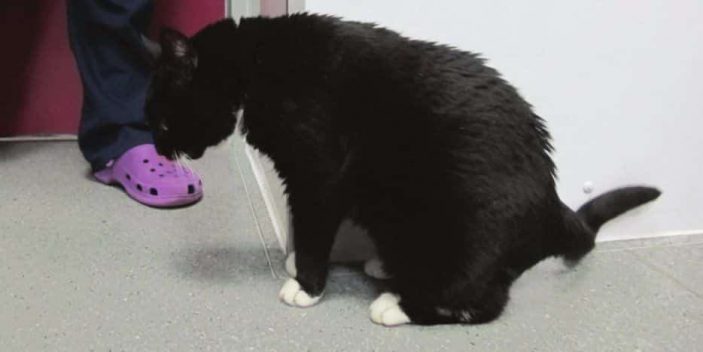Hypokalemia refers to low potassium in a cat’s blood characterized by general muscle weakness, inability to raise their head, among other symptoms. It occurs when potassium levels go below the normal range of 3.4 and 5.6 MEQ/L
Potassium one of the positively charged ion or cationic (K+) electrolyte with many vital functions that comprise aiding in normal functions of muscles including cardiac and cell signaling among other functions.
Most of K+ resides inside cells with only a small amount found in the intracellular fluids.
Finally, the kidney helps in maintaining a closely regulated level of this cationic electrolyte in blood serum.
Symptoms of low potassium in cats
Sick cats frequently suffer from mild to moderate cases of hypokalemia which does not present any clinical signs. However, cases of severe cases may result in some symptoms.

Also, mild to moderate low potassium is common in elderly cats due to a number of reasons.
In the case of hypokalemia, the most commonly noted symptoms include generalized muscle weakness that may be accompanied by ventroflexion of the neck (cat head dropping) and difficulty in walking (walks like it is drunk).
Other common symptoms include increased urination and thirst, loss of appetite, increased heartbeat rate (tachycardia), depression, lack of appetite, vomiting, lethargy, muscle pain, arrhythmias, muscle mass loss, weight loss, and difficulty in breathing due to paralysis of the muscles that help in breathing.
Severe cases especially if it affects cardiac muscle function or respiratory muscles, paralysis or even death can occur.
Causes of low potassium levels in cats
- Renal losses via urine due to chronic kidney disease, renal tubular acidosis, diabetes or diuretics including medicines such as furosemide and IV fluids. Also, post-obstructive diuresis that follows relief of urethral obstruction and post-administration of loop or thiazide diuretics can be a cause.
- Cellular translocation commonly noted in insulin receiving diabetic felines, metabolic acidosis (a metabolic disease), administration of sodium bicarbonate or glucose as well as due to the role of catecholamines where potassium moves from extracellular fluids into cells.
- Decreased intake such as relying on low potassium cat foods, lack of appetite, starvation or inadequate amounts of food as well as GI malabsorption including blockage.
- Hyperaldosteronism, both primary and secondary may affect hormones such as cortisol and aldosterone release. Aldosterone helps in excretion of K+.
- Cats on dialysis
- GI losses through severe vomiting diarrhea
- Use of some antibiotics or use of amlodipine in cats with chronic renal insufficiency
- Hereditary cases noted in Burmese cats and breeds closely related to them.
- Hyperthyroidism
Besides the above causes, some muscle diseases, adrenaline release especially due to stress, bacterial endotoxemias, and very high corticosteroid medications doses are associated with hypokalemia [2]
Diagnosis
Your vet will begin by asking more pertaining to your cat’s history including when the clinical signs began, how they have been progressing, any medicines, medical conditions, incidents, and so on.
Afterward, he or she may conduct a physical examination of body systems and request for various tests to rule out other conditions that cause similar symptoms or find out the underlying causes.
These tests may include:
- Blood chemistry profile – Will show low potassium levels. A high BUN and creatinine will indicate renal failure.
- Complete blood count – be indicative of instances of anemia in case of chronic renal failure.
- Urinalysis – Measure K+ in urine, specific gravity to determine its concentration. Also, high ketones and glucose may indicate diabetes.
- Electrocardiogram – check if heart function is normal.
- Abdominal MRI, CT-Scans, ultrasound, and X-ray may help detect any underlying cause.
There are chances of measurement error due to pseudohypokalemia where cells that are still metabolically active may take too much potassium after a sample has been collected.
Treatment
Severe cases will require emergency attention where patients may be hospitalized for intensive nursing care and treatment.
Treatment will involve taking measures intended to restore normal potassium in a cat’s blood as well as treating any life-threatening symptoms like irregular heartbeats and breathing muscle paralysis. This will include but not limited to:
- Administration of potassium-containing fluids either subcutaneously or intravenously (better but should be done slowly to avoid hyperkalemia) to help restore K+ to its normal levels such as using KCl or KH2PO4.
- Prevent further losses by controlling diarrhea, vomiting, stopping any IV fluids, diuretics or any medications that cause further loss.
- Treating or managing any underlying condition including chronic renal failure including oxygen therapy.
- Giving your cats potassium supplements including Tumil K, Renal K+ for Cats and Dogs which is essentially a potassium gluconate gel for cats and dogs. There are also potassium tablets or powders. Let your vet help you with supplementation if your cat uses insulin.
- Change to high potassium cat foods to help reduce deficiency in a cat’s chances.
- In the case of kidney disease, increased urination results in loss of soluble vitamin B complex and potassium through urine. Ensure you also vitamin B supplements. Most renal diets are “low in phosphorus and supplemented with B vitamins and potassium” notes Animal Medical Center.
Recovery will take up to three days before this electrolyte’s level comes to normal. During this time, continuously monitoring of the serum K+ level is important to ensure there is no relapse or your cat does not end up a case of hyperkalemia.
